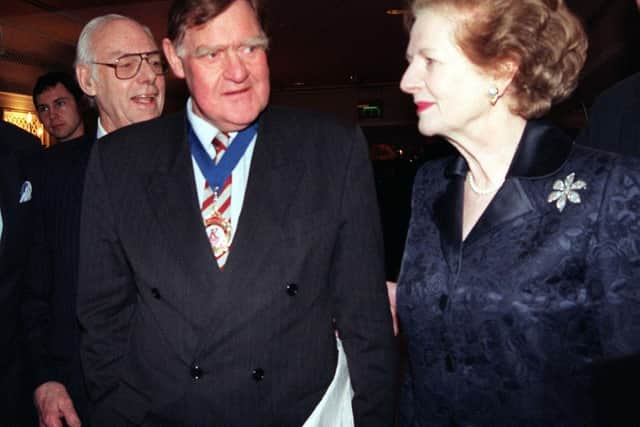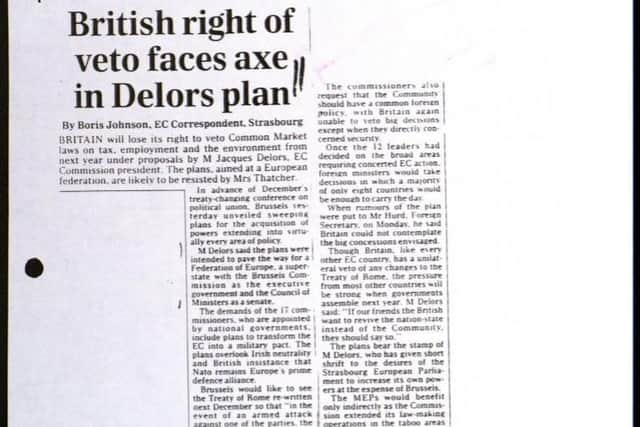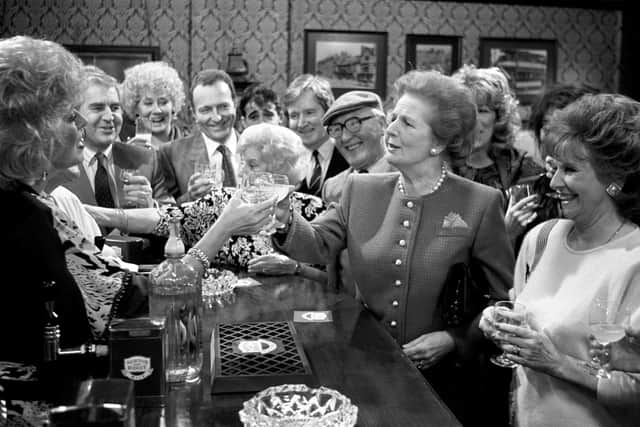Archives reveal Boris Johnson's potential role in Margaret Thatcher's downfall - and her penchant for naming clothes after world leaders
While working as the Daily Telegraph’s Brussels Correspondent in 1990, Mr Johnson wrote an article about European Commission president Jacques Delors, which has been described as “not quite right”.
It was headlined 'British Right Of Veto Faces Axe In Delors Plan' and Mrs Thatcher marked two lines beside the headline on a cutting of the article in her despatch box file.
Advertisement
Hide AdAdvertisement
Hide AdShe also marked two lines beside a paragraph which read: "M Delors said the plans were intended to pave the way for a Federation of Europe, a super-state with the Brussels Commission as the executive government and the Council of Ministers as a senate."


But Chris Collins, from the Margaret Thatcher Archive Trust which is making the documents available to the public, said Mr Johnson's article was "not quite right".
A memo written two days later by senior Foreign Office official Richard Gozney to Mrs Thatcher's Private Secretary Charles Powell, and also kept in the Number 10 file, noted: "The Commission Opinion itself... does not contain what M Delors is reported by the Daily Telegraph as having suggested.
"It does not propose any radical change in the present institutional plans of the Community - although it does contain a lot of other horrors."
Advertisement
Hide AdAdvertisement
Hide AdOn October 30, Mrs Thatcher made a House of Commons statement in which she defiantly declared "no, no, no" to M Delors.


The statement came during a time of intense division in the Tory party over Europe and proved too much for Sir Geoffrey Howe, who quit as leader of the Commons and deputy prime minister days later and made a devastating resignation speech from which Mrs Thatcher never recovered.
She was ousted a few days later.
Mr Collins said Mr Johnson's article was "not quite right" and Mrs Thatcher "knows it's not quite right".
But he added: "A lot of Conservatives would read articles like that one by Boris Johnson - I'm sure it wasn't the only one written at the time - and say 'yes, that's what these guys (in Brussels) are up to'.


Advertisement
Hide AdAdvertisement
Hide Ad"Those pressures are all around her and she is treading this terribly, perilously difficult path.
"It's not clear that she wanted a war, as it were, and yet she feels many of these things too and she's got this sinuous route to follow.
"While I'm not saying this is the cause of her downfall or anything like that - it would be absurd to suggest that - the forces that are in play are somewhat revealed by the presence of that article."
The newly-released documents also showed Mrs Thatcher kept a clothing diary in her latter years as prime minister and named many of her outfits after Russian leader Mikhail Gorbachev and some after BBC broadcaster Terry Wogan, newly-released documents show.


Advertisement
Hide AdAdvertisement
Hide AdShe apparently began to keep a note of what she wore in 1988, and diary entries for 1990 record that she wore her "Pink Chanel Gorbachev" to Coronation Street and her "Wogan Burgundy" to the Bank of England.
Wogan, who interviewed Mrs Thatcher in January 1990, appeared to have several outfits named after him including a "Wogan Long" and a "Wogan Short", though these may have been variations on a single outfit.
Soviet politician Mr Gorbachev had the most outfits named after him, followed by US President Ronald Reagan.
"It's interesting that so many were named for their association with Gorbachev," said Mr Collins. "She really was showing off on her Soviet trips - glamour was part of her approach to ending the Cold War.
Advertisement
Hide AdAdvertisement
Hide Ad"Reagan was second in the naming stakes, while (US President George HW) Bush, (Chancellor of Germany Helmut) Kohl and (French President Francois) Mitterrand predictably got nothing at all."
In one 1990 diary entry, Mrs Thatcher is recorded as wearing her "Black Dull Suit" to meet President Bush.


When the prime minister formally tendered her resignation to the Queen on November 28 1990, her clothing diary states she wore her "Burgundy New York W Velvet Collar".
Mr Collins said he believes Mrs Thatcher's first clothing diary was in 1988 and she "cranks up her whole clothing operation after the visit to Moscow in 1987", on her historic tour of the Soviet Union.
Advertisement
Hide AdAdvertisement
Hide Ad"She's suddenly, I think, aware of the power of clothes," he said. "She was interested before and very keen on things like British Fashion Week.
"She begins then to see that this is actual serious politics and she's got more clothes and she's monitoring what she's doing with them.
"It comes together."
He described it as the "new regime" of Mrs Thatcher's "dress adviser", Margaret King, who was also a director of the British fashion house Aquascutum.
"Possibly Margaret King said to her ... 'You should keep a proper note of what you wore and then we can juggle it around and shift this and that'," he said.
Advertisement
Hide AdAdvertisement
Hide AdHe continued: "It's interesting that she chooses to name things after (Terry Wogan) but, for example, she chose to name a dress when she met President Mitterand at Waddesdon Park in May in 1990 but she named it Waddesdon.
"Only certain men got the accolade of having a dress named after them."
He said clothes were a "great joy" for the prime minister.
"She had them very carefully looked after and, in fact, in her office there was a huge room where her driver sat - this is after leaving Number 10," he said.
"It was a very big room and it was full of clothing lines and all of the clothes had their own zipped-up bags with the names on.
"There were maybe 200.
Advertisement
Hide AdAdvertisement
Hide Ad"Huge numbers of these clothes, vast numbers, and she knew every one, no question.
"They were lovingly looked after and they were a great joy to her. I mean, she loved clothes, they were a real pleasure in her day."
Her final letter as prime minister has also been revealed to be a heartfelt thank you to a loyal member of her staff, while in contrast she sent stock replies to some political colleagues who wrote to her after her resignation.
Sir Bernard Ingham, now a Yorkshire Post columnist, spent 11 years as Mrs Thatcher's chief press secretary, from 1979 to 1990, and was knighted in her 1990 resignation honours list.
Advertisement
Hide AdAdvertisement
Hide AdIn a letter dated November 28 1990, Thatcher wrote: "Dear Bernard. My last act as prime minister must be to thank you, from the bottom of my heart, for 11 years of loyal and trusty service and companionship."
She continued: "As I look back on my years as prime minister, I shall always remember you as the man who stood by me through thick and thin.
"I fear the strain on you and your family must have been very great: but you never complained and were always there when needed.
"So it is with great admiration and heart-felt thanks that Denis (Thatcher's husband) and I say goodbye to you and to No. 10 - for the two are almost inseparable in our minds - and wish you and Nancy (Ingham's wife) every happiness."
Advertisement
Hide AdAdvertisement
Hide AdMrs Thatcher signed off the letter by handwriting "with warmest regards from all the family, Margaret", with Denis Thatcher also signing his name.
Charles Powell, a foreign policy adviser to Mrs Thatcher, wrote her a letter on her resignation.
He said that she "showed a level of greatness which will not be matched in Britain's politics again".
There is no sign of her reply.
Many of Mrs Thatcher's political colleagues also wrote meaningfully to her on her resignation, including the MP Ken Clarke.
Advertisement
Hide AdAdvertisement
Hide AdHe wrote: "It has been a privilege to have served in the government of a truly great prime minister.
"I will always be grateful to you and loyal in defence of your achievements."
His letter has "stock" written at the top of it, and he was sent a template reply beginning "Thank you so much for your kind and generous message".
Mr Collins said Sir Bernard was Thatcher's longest-serving member of staff and described her letter to him as "moving".
Advertisement
Hide AdAdvertisement
Hide Ad"I can sense this tremendous emotion as the staff breaks up too and it's so difficult for her and for them," he said.
"Everybody loved her, around her.
"It's such a contrast between her very difficult relationship with colleagues and her very warm, almost loving relationships with many long-lasting staff members.
"They are the family.
"There really is this sort of feel."
The Margaret Thatcher Archive Trust is gradually overseeing the release of her private files through the Churchill Archive Centre in Cambridge.
Members of the public will be able to browse the archive from Saturday by visiting www.margaretthatcher.org.